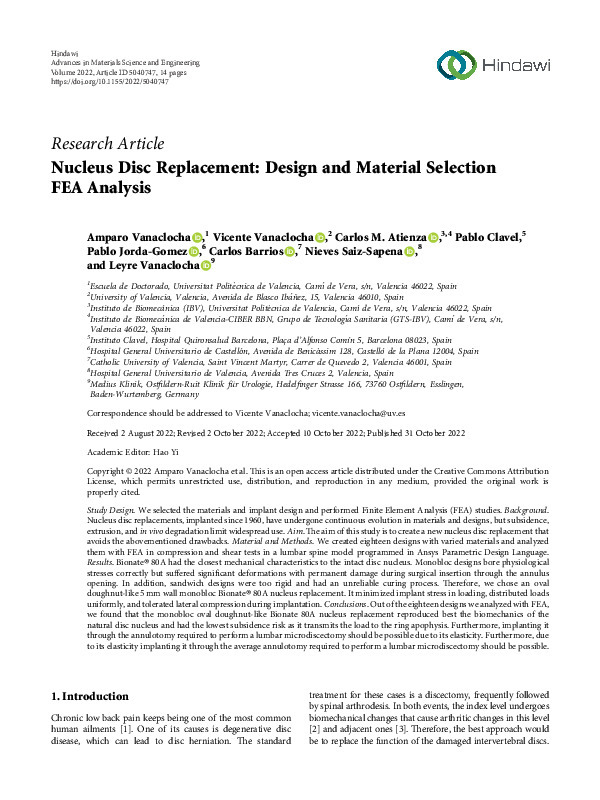JavaScript is disabled for your browser. Some features of this site may not work without it.
Buscar en RiuNet
Listar
Mi cuenta
Estadísticas
Ayuda RiuNet
Admin. UPV
Nucleus Disc Replacement: Design and Material Selection FEA Analysis
Mostrar el registro sencillo del ítem
Ficheros en el ítem
| dc.contributor.author | Vanaclocha, Amparo
|
es_ES |
| dc.contributor.author | Vanaclocha, Vicente
|
es_ES |
| dc.contributor.author | ATIENZA VICENTE, CARLOS MANUEL
|
es_ES |
| dc.contributor.author | Clavel, Pablo
|
es_ES |
| dc.contributor.author | Jordá-Gómez, Pablo
|
es_ES |
| dc.contributor.author | Barrios, Carlos
|
es_ES |
| dc.contributor.author | Saiz-Sapena, Nieves
|
es_ES |
| dc.contributor.author | Vanaclocha, Leyre
|
es_ES |
| dc.date.accessioned | 2023-06-07T18:01:11Z | |
| dc.date.available | 2023-06-07T18:01:11Z | |
| dc.date.issued | 2022-10-31 | es_ES |
| dc.identifier.issn | 1687-8434 | es_ES |
| dc.identifier.uri | http://hdl.handle.net/10251/193934 | |
| dc.description.abstract | [EN] Study Design. We selected the materials and implant design and performed Finite Element Analysis (FEA) studies. Background. Nucleus disc replacements, implanted since 1960, have undergone continuous evolution in materials and designs, but subsidence, extrusion, and in vivo degradation limit widespread use. Aim. The aim of this study is to create a new nucleus disc replacement that avoids the abovementioned drawbacks. Material and Methods. We created eighteen designs with varied materials and analyzed them with FEA in compression and shear tests in a lumbar spine model programmed in Ansys Parametric Design Language. Results. Bionate® 80A had the closest mechanical characteristics to the intact disc nucleus. Monobloc designs bore physiological stresses correctly but suffered significant deformations with permanent damage during surgical insertion through the annulus opening. In addition, sandwich designs were too rigid and had an unreliable curing process. Therefore, we chose an oval doughnut-like 5¿mm wall monobloc Bionate® 80A nucleus replacement. It minimized implant stress in loading, distributed loads uniformly, and tolerated lateral compression during implantation. Conclusions. Out of the eighteen designs we analyzed with FEA, we found that the monobloc oval doughnut-like Bionate 80A nucleus replacement reproduced best the biomechanics of the natural disc nucleus and had the lowest subsidence risk as it transmits the load to the ring apophysis. Furthermore, implanting it through the annulotomy required to perform a lumbar microdiscectomy should be possible due to its elasticity. Furthermore, due to its elasticity implanting it through the average annulotomy required to perform a lumbar microdiscectomy should be possible. | es_ES |
| dc.description.sponsorship | This work was supported by the European Union's 6th Framework Programme under project number IP 026599-s | es_ES |
| dc.language | Inglés | es_ES |
| dc.publisher | Hindawi Limited | es_ES |
| dc.relation.ispartof | Advances in Materials Science and Engineering | es_ES |
| dc.rights | Reserva de todos los derechos | es_ES |
| dc.subject | Finite-Element-Analysis | es_ES |
| dc.subject | Lumbar Spine | es_ES |
| dc.subject | Intervertebral Discs | es_ES |
| dc.subject | Artificial Disc | es_ES |
| dc.subject | Pulposus | es_ES |
| dc.subject | Compliant | es_ES |
| dc.subject | Behavior | es_ES |
| dc.subject | Segment | es_ES |
| dc.subject | Model | es_ES |
| dc.subject | Core | es_ES |
| dc.subject.classification | INGENIERIA MECANICA | es_ES |
| dc.title | Nucleus Disc Replacement: Design and Material Selection FEA Analysis | es_ES |
| dc.type | Artículo | es_ES |
| dc.identifier.doi | 10.1155/2022/5040747 | es_ES |
| dc.relation.projectID | info:eu-repo/grantAgreement/EC//026599-s/ | es_ES |
| dc.rights.accessRights | Abierto | es_ES |
| dc.contributor.affiliation | Universitat Politècnica de València. Escuela Técnica Superior de Ingenieros Industriales - Escola Tècnica Superior d'Enginyers Industrials | es_ES |
| dc.description.bibliographicCitation | Vanaclocha, A.; Vanaclocha, V.; Atienza Vicente, CM.; Clavel, P.; Jordá-Gómez, P.; Barrios, C.; Saiz-Sapena, N.... (2022). Nucleus Disc Replacement: Design and Material Selection FEA Analysis. Advances in Materials Science and Engineering. 2022:1-14. https://doi.org/10.1155/2022/5040747 | es_ES |
| dc.description.accrualMethod | S | es_ES |
| dc.relation.publisherversion | https://doi.org/10.1155/2022/5040747 | es_ES |
| dc.description.upvformatpinicio | 1 | es_ES |
| dc.description.upvformatpfin | 14 | es_ES |
| dc.type.version | info:eu-repo/semantics/publishedVersion | es_ES |
| dc.description.volume | 2022 | es_ES |
| dc.relation.pasarela | S\477615 | es_ES |
| dc.contributor.funder | European Commission | es_ES |








